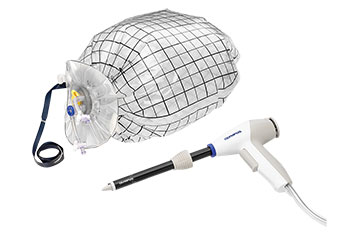FDA Finalizes Guidance on Power Morcellation Labeling Changes that Now Indicate Use of Power Morcellation Only with an Approved, Compatible Containment System

The ASC/Olympus PneumoLiner labeling update has been finalized by the FDA, to allow for a wider range of patient candidates needing removal of non-malignant fibroids.
CENTER VALLEY, Pa., (February 3, 2021) – Olympus announced today that it supports the finalized guidance recommendations from the Food and Drug Administration (FDA) indicating that laparoscopic power morcellation in gynecological procedures must be conducted with an approved containment device.
The final FDA Guidance on Power Morcellator labeling requires that all power morcellators currently marketed in the U.S. will require revisions to contraindications and indications for use such that the morcellator be used only with a compatible, FDA-cleared containment device. Currently, Olympus is the only company with such a containment device.
“Physicians now have a clear and safe choice for their patients. The use of an FDA-approved containment system allows the safe use of power morcellation in appropriate patients,” said Dr. Jubilee Brown, Professor of Gynecologic Oncology at Atrium Health. “Fortunately, since there is a containment system with a proven track recordi, eligible patients can undergo minimally invasive surgery and be more likely to avoid the risks of open surgery.”ii, iii
Indications for use have also been clarified to reflect those women who can be appropriately treated using contained morcellation. This modification removes ambiguous language related to women with fibroids who are of “peri-menopausal status” to “women with fibroids who are pre-menopausal and under age 50,” a change supported by data to support higher risk of occult fibroid cancers in the older of those age brackets. The FDA continues to advise that power morcellation should not be used in post-menopausal women or with any women with a known or suspected malignancy.
In addition, final label modifications also recommend information on labeling that uncontained morcellation can spread benign tissue, which can potentially result in repeat surgeries. The previously issued Safety Guidance was also updated to reflect these modifications.
From the time of the PneumoLiner’s DeNovo clearance in 2016, Olympus has sold its PK Morcellator only together with the containment system. In addition, Olympus has made the PneumoLiner available to physicians choosing an alternate to the Olympus morcellator, provided there was device compatibility. Olympus has also supported the elimination of the term “peri-menopausal,” based on feedback from physicians that the term was too broad to determine patient eligibility. In addition, as has now been acknowledged by the FDA, Olympus has long held that containment is a useful means of reducing the spread of benign tissue into the abdominal cavity, in which pathologies (like fibroids) may regrow when tissue or cells are inadvertently left behind, potentially resulting in further surgeries for these patients.
A recent study examining the impact from the FDA’s original warning regarding morcellation in 2014 found that hospitals that had banned morcellation after FDA warnings -- wherein doctors who once performed high volumes of minimally invasive laparoscopic supracervical hysterectomy were forced to perform open hysterectomy – were seeing the complication risk increase when cases shifted considerably toward open abdominal hysterectomy.iv
“This move by the FDA, based on the published data pertaining to morcellation and including new requirements to pre-screen patients and use appropriate patient selection, means that many more women will benefit from a minimally invasive approach to surgery,” said Manisha Shah-Bugaj, Vice President, General Manager, Global Gynecology, Olympus Corporation of the Americas. “The FDA has provided added protection by requiring contained morcellation as a risk mitigation approach.”
With the new guidance, Olympus will be updating its product labeling to reflect the FDA’s guidance.
Those interested in the Olympus Contained Tissue Extraction system or PneumoLiner should contact their Olympus sales representatives for more information or visit https://medical.olympusamerica.com/products/contained-tissue-extraction-system.
# # #
About Olympus Medical Systems Group
Olympus is passionate about the solutions it creates for the medical, life sciences, and industrial equipment industries.
Olympus’ Medical business uses innovative capabilities in medical technology, therapeutic intervention, and precision manufacturing to help healthcare professionals deliver diagnostic, therapeutic, and minimally invasive procedures to improve clinical outcomes, reduce overall costs, and enhance the quality of life for patients. Olympus’ Medical portfolio includes endoscopes, laparoscopes, and video imaging systems, as well as surgical energy devices, system integration solutions, medical services, and a wide range of endotherapy instruments. For more information, visit medical.olympusamerica.com.
About Advanced Surgical Concepts
Advanced Surgical Concepts (ASC) works closely with surgeons and specialist clinicians to conceive of new approaches to performing surgeries. In so doing, ASC designs and develops new medical devices in order to standardize the methods by which particular surgeries or diagnostic procedures will be performed. For more information, visit ASC at http://www.advancedsurgical.ie/.
- FDA allows marketing of first-of-kind tissue containment system for use with certain laparoscopic power morcellators in select patients. U.S. Food and Drug Administration. https://www.fda.gov/news-events/press-announcements/fda-allows-marketing-first-kind-tissue-containment-system-use-certain-laparoscopic-power. Published April 7, 2016.
- An open letter to the FDA regarding the use of morcellation procedures for women having surgery for presumed uterine fibroids. The American Association of Gynecologic Laparoscopists. https://www.aagl.org/wp-content/uploads/2015/12/open-letter-to-FDA-re-morcellation-with-cities.pdf.
- Siedhoff MT, Wheeler SB, Rutstein SE, Geller EJ, Doll KM, Wu JM, Clarke-Pearson DL. Laparoscopic hysterectomy with morcellation vs abdominal hysterectomy for presumed fibroid tumors in premenopausal women: a decision analysis. J Obstet Gynecol. 2015;212:591.e1-8
- Xiao Xu, PhD, Vrunda B. Desai, MD, Jason D. Wright, MD, Haiqun Lin, MD, PhD, Peter E. Schwartz, MD Cary P. Gross, MD. Hospital Variation in Responses to Safety Warnings about Power Morcellation in Hysterectomy. American Journal of Obstetrics and Gynecology. December 22, 2020. DOI: https://doi.org/10.1016/j.ajog.2020.12.1207

